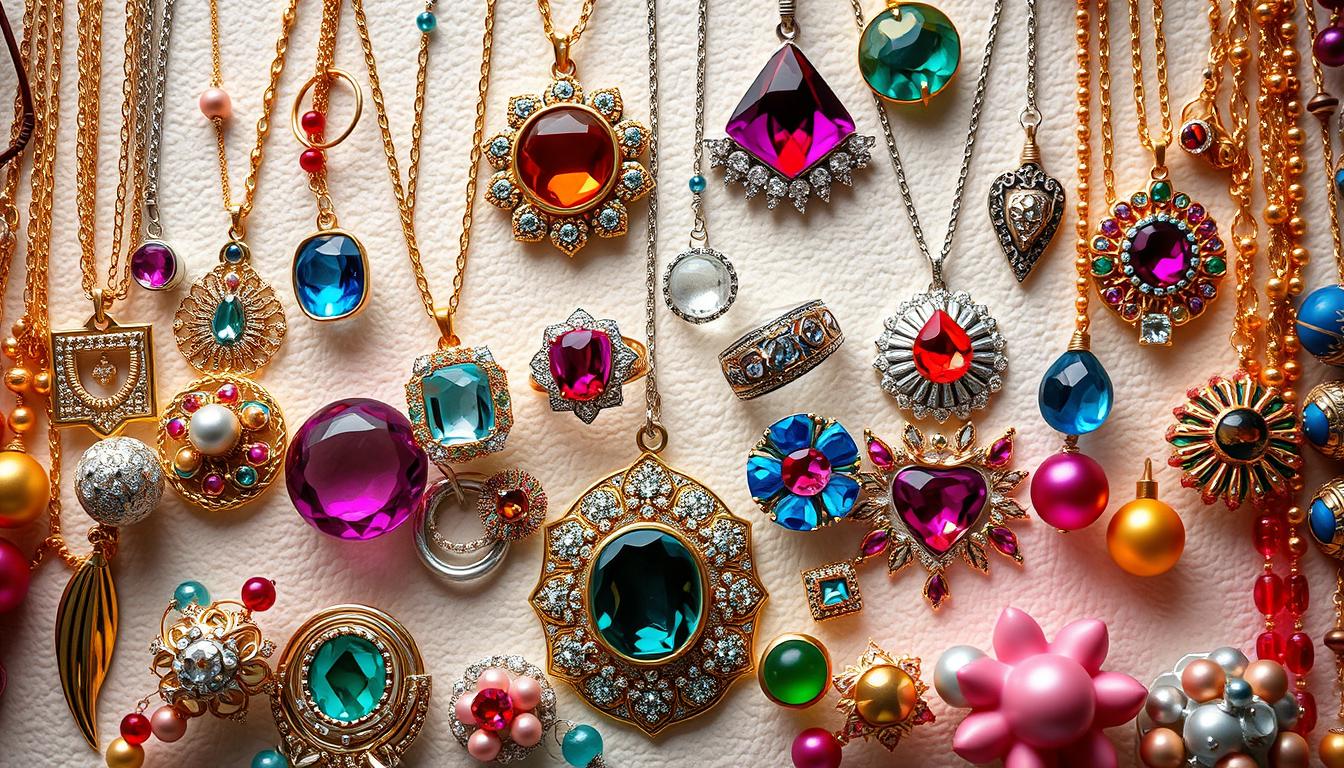Finding the right fashion school can be tough with so many choices. The fashion world has many paths, like designing clothes and marketing them. It’s important to pick a school that balances creativity, skill, and discipline.
Look for schools with unique programs and a wide range of courses. They should also offer chances to study abroad, join clubs, and get internships. Top schools have great facilities, are in good locations, and have strong connections in the fashion world.
Key Takeaways
- Explore fashion design schools that offer specialized programs, diverse curriculums, and hands-on learning opportunities.
- Consider schools with excellent facilities, strategic locations, and experienced faculty connected to the fashion industry.
- Seek out programs that provide study-abroad options, extracurricular activities, and internship experiences.
- Evaluate the school’s reputation, alumni network, and career placement rates to ensure a strong return on your investment.
- Prioritize fashion design schools that strike a balance between creativity, technical expertise, and industry-relevant skills.
1. Introduction to Fashion Design Education
Fashion design education covers many areas, like creative design and merchandising. Students learn about design, pattern making, and textiles. Going to a fashion school helps designers improve their skills and knowledge.
Understanding Fashion Design
Fashion design is a mix of art, technical skills, and business. Students learn to create designs and make clothes. These skills are key for success in the fashion world.
Why Choose a Fashion Design School?
Choosing a fashion design school has many benefits. Students get hands-on experience and learn about the latest trends. They also meet people in the industry, which helps them grow professionally.
Looking for fashion institutes close by or apparel design programs in my area? The right education can change your career. It’s a step towards making your dreams in fashion come true.
2. Factors to Consider When Choosing a School
Choosing the right fashion design school is a big decision. It can greatly affect your future in the fashion world. There are important things to think about to find the best school for you. Let’s look at the main points to consider when picking a fashion merchandising or marketing college.
Location and Accessibility
The school’s location is key. Look for schools that are easy to get to, with good transport links. Some schools offer online or part-time classes, which are great for those with tight schedules.
Program Accreditation
Make sure the program you’re interested in is accredited. Accreditation shows the program’s quality and makes your degree more valuable. It helps you stand out to employers in fashion marketing.
Faculty and Industry Connections
The teachers at a fashion school are very important. Look for schools with experienced teachers who know the fashion world well. Schools that offer internships and networking can also be very helpful.
Curriculum and Specializations
Check the school’s curriculum and specializations. Choose a program that fits your interests and career goals. Look for hands-on learning, modern technology, and coursework that’s relevant to the industry.
| School | Specializations | Industry Connections | Accreditation |
|---|---|---|---|
| Johnson County Community College (JCCC) |
|
|
Accredited by the Higher Learning Commission |
| Central Saint Martins |
|
|
Accredited by the University of the Arts London |
By thinking about these factors, you can make a smart choice. You can find a fashion design school that matches your goals, whether you’re looking for merchandising or marketing programs.
3. Top Fashion Design Schools in [Your City/Region]
The [Your City/Region] area is a hub for fashion design education. It’s home to top schools that have shaped the industry. These schools offer a wide range of programs to prepare students for a career in fashion.
Overview of Leading Institutions
The Fashion Institute of Technology (FIT) in New York City offers over 48 undergraduate degrees. This includes Fashion Design and Fashion Business Management. Parsons School of Design is famous for its approach to design education. It has produced designers like Tom Ford and Marc Jacobs.
Unique Programs Offered
- Woodbury University has a B.B.A. in Fashion Marketing and a B.F.A. in Fashion Design. This gives students a well-rounded education.
- The Fashion Institute of Design & Merchandising (FIDM) includes internships in its curriculum. This helps students make industry connections and find jobs.
- Beverly Hills Design Institute is the only French Haute Couture school in the U.S. It offers programs in pattern design and fashion design.
Alumni Success Stories
These schools have a history of producing successful alumni. Otis College of Art and Design has an 86% employment rate for fashion design graduates within 3 months. Employers include Adidas, Calvin Klein, and Urban Outfitters.
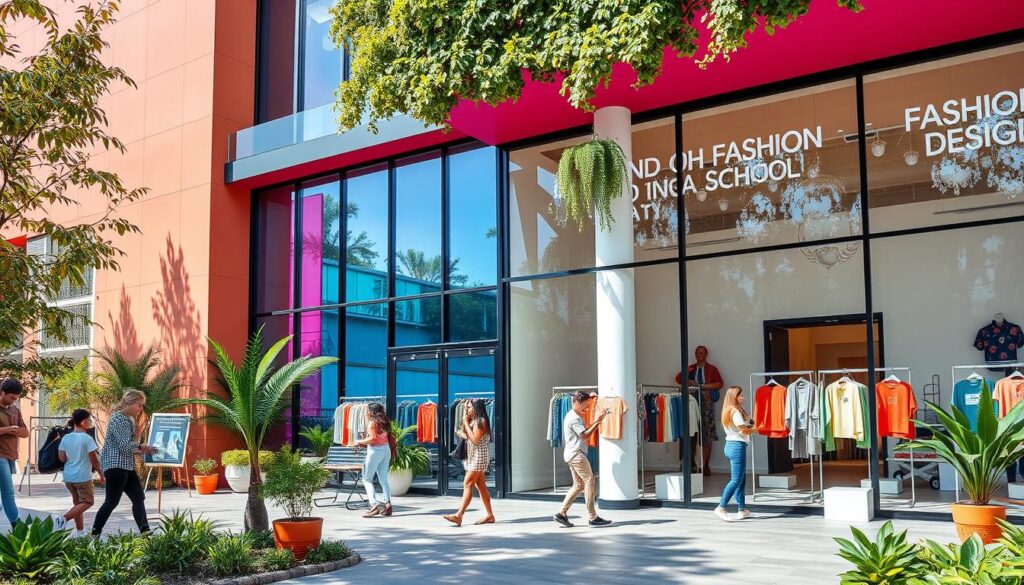
These institutions have strong partnerships with major fashion brands. This gives students valuable industry connections and real-world experiences. It helps them stand out in their fashion design careers.
4. Online vs. Traditional Fashion Design Schools
Aspiring fashion designers now face a big choice: online or traditional schools. Each has its own benefits, fitting different learning styles and lives.
Benefits of Online Learning
Online fashion design programs are becoming popular. They offer fashion technology programs close to me and fashion design courses nearby. This makes learning easy for those with busy lives. Students can learn at their own speed, fitting it into their schedule.
Advantages of In-Person Classes
In-person schools still have a lot to offer. They give hands-on experience with real tools and materials. This helps students learn by doing, not just reading.
Being in class also means you can talk to teachers and classmates. This helps you learn faster and makes friends in the industry.
Choosing between online and in-person schools depends on what you need. Think about your learning style, life, and career dreams. Each option has its own strengths, so pick what’s best for you.
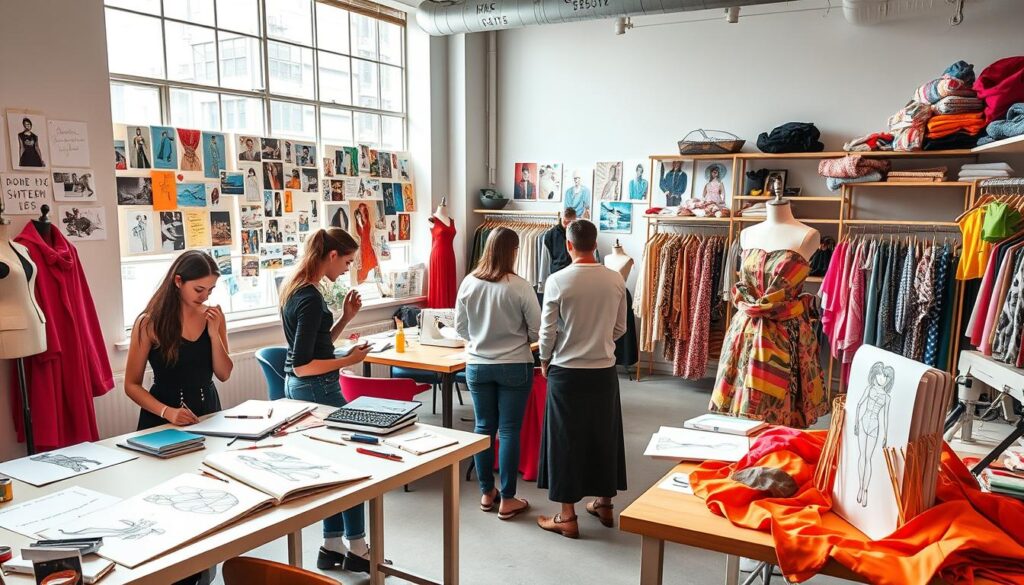
“The best fashion design programs, whether online or in-person, will equip students with the necessary skills and knowledge to thrive in the dynamic fashion industry.”
5. Financial Considerations for Fashion Design Programs
Starting a fashion design education is exciting, but think about the money. The cost of these programs varies a lot. This includes tuition, materials, and living costs. But, you can find affordable options that still offer great education.
Tuition Costs and Fees
Fashion design programs have different prices. Some are more affordable for local students. When looking at fashion institutes close by or apparel design programs in my area, check the tuition and fees. Also, think about extra costs like materials. Many schools list this info online, making it easier to compare.
Financial Aid Opportunities
There are many ways to get financial help for fashion design students. Schools offer scholarships, grants, and work-study programs. Look into these options at the schools you’re interested in. They can really help with the cost of your education.
Scholarships and Grants Available
There are also grants and scholarships from the fashion industry. Look into these external funding sources. They can help you reach your education goals without spending too much.
“Investing in your fashion design education is not just about the cost, but the long-term benefits it can bring to your career. With careful planning and exploration of financial aid options, you can turn your fashion design dreams into reality.”
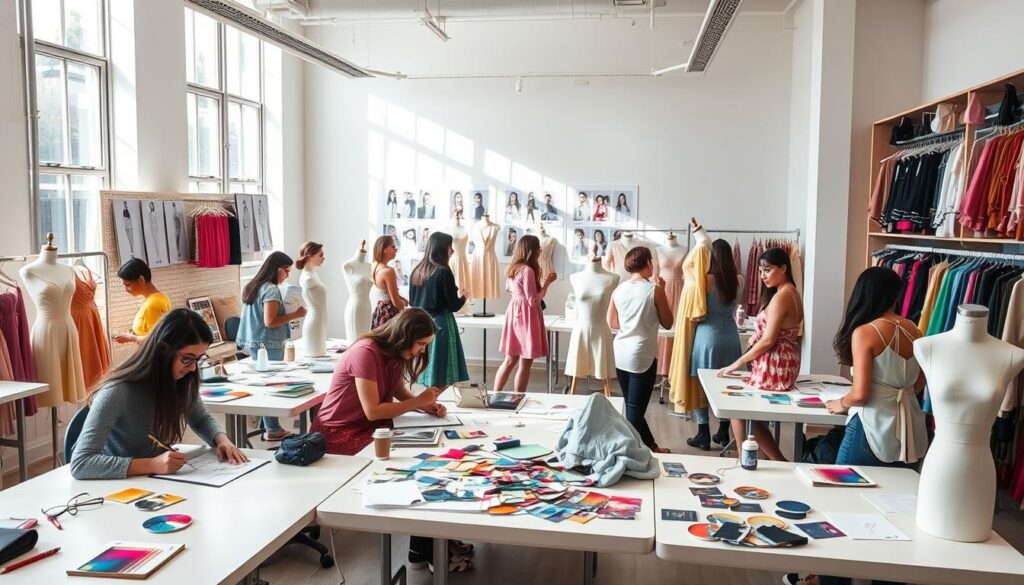
By looking at tuition, financial aid, and scholarships, you can choose the rightfashion institutes close byorapparel design programs in my area. This way, you can meet your academic and financial goals.
6. Popular Fashion Design Specializations
Fashion design programs offer many specializations. This lets students focus their education and career paths. Whether you love making new clothes, designing fabrics, or the business side, there’s something for everyone.
Apparel Design
Apparel design programs teach students to create clothing collections. They learn about sketching, pattern-making, and sewing. Graduates often become fashion designers, pattern makers, and costume designers.
Textile Design
Textile design programs focus on making fabrics. Students learn about fibers, dyeing, and printing. Textile designers work in fashion, interiors, and even cars.
Fashion Marketing and Merchandising
For those who like the business side, there are programs in fashion marketing and merchandising. They cover trends, brands, retail, and visual merchandising. Graduates can be fashion buyers, stylists, or marketing specialists.
Costume Design
Costume design programs are for those who love creating outfits for performances. Students learn about fashion history and construction. Costume designers work in theater, film, and TV.
When picking a fashion design specialization, think about what you’re interested in. Look for textile design schools and fashion merchandising schools near you. Find the program that fits your goals.
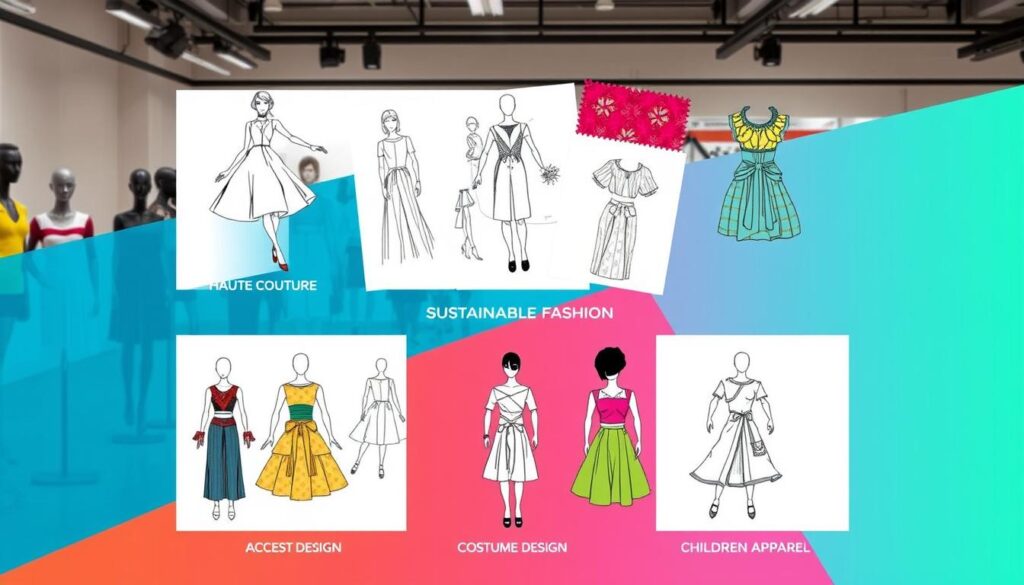
7. Internships and Real-World Experience
Internships are key for a good fashion design education. They let fashion design students use what they learn in class. They also get real-world experience. Many fashion marketing colleges near me and fashion design courses nearby work with big fashion brands. This makes it easy for students to find internships.
Importance of Internships
Internships help students make professional connections. They also improve their resumes. At the University of Wisconsin-Stout, students get work experience through co-ops and internships. They work with major fashion and retail companies.
Students from the B.S. Fashion Design & Development program at the University of Wisconsin-Stout find jobs all over the country. They work for top fashion companies.
How to Secure a Fashion Internship
- Develop a strong portfolio showcasing your design skills and creativity.
- Network at industry events and utilize your school’s career services to connect with potential internship opportunities.
- Many fashion design programs, such as the one at Marist College, include internships as part of their curriculum, ensuring students graduate with practical experience.
Internships are crucial for fashion design students. They get real experience and make industry connections. This prepares them for their future careers. Graduates from fashion marketing colleges near me and fashion design courses nearby are ready to succeed in the fashion world.
| Institution | Internship Opportunities | Graduate Success |
|---|---|---|
| University of Wisconsin-Stout | Co-ops and internships with major fashion and retail companies | Graduates work at top fashion and retail companies nationwide |
| Marist College | Over 83% of students complete at least one internship | Culminating fashion show, the Silver Needle Runway |
8. Career Opportunities After Graduation
After graduating in fashion design, you’ll find many career paths open to you. You can become a fashion designer, textile designer, or even a pattern maker. There are also roles in fashion merchandising, buying, trend forecasting, and marketing.
With experience, you can move up to bigger roles. You might become a trend director, technical designer, or quality control manager. You can also start your own business or work as a freelancer, giving you creative freedom.
Job Prospects in Fashion Design
The fashion industry is booming, and there’s a high demand for skilled designers. As a graduate, you can explore careers in:
- Fashion Design
- Textile Design
- Pattern Making
- Fashion Illustration
- Product Development
Common Careers in the Industry
There are also many other roles you can excel in, like:
- Fashion Merchandising
- Fashion Buying
- Trend Forecasting
- Fashion Marketing
The fashion industry offers many career paths. You can use your creativity, technical skills, and business knowledge to succeed. Whether you dream of working for a famous fashion house or starting your own label, the possibilities are endless.
9. Networking in the Fashion Industry
Getting ahead in fashion isn’t just about being smart; it’s about who you know. Building a strong network can lead to jobs, internships, and even partnerships. By joining the fashion community, you can boost your career.
Building Industry Connections
Start by connecting with fashion institutes close by and local fashion colleges. They host events like fashion shows and workshops. These are great chances to meet industry leaders and learn from them.
Internships and co-op programs are also key for networking. Working with experts lets you build real relationships and gain valuable experience. Plus, alumni networks can connect you with people who’ve already made it in fashion.
Attending Fashion Events and Workshops
Stay current with fashion trends by attending events and workshops. Fashion weeks, trade shows, and conferences are perfect for meeting people and learning about new trends. You might even find your next job.
Workshops and masterclasses are also crucial. They’re often run by fashion institutes close by or local fashion colleges. Here, you can learn from the best and meet others who share your passion for fashion.
By diving into the fashion world and using your network, you can become a key player. This will help you succeed in the fast-changing fashion industry.
“The fashion industry is all about connections. The more people you know, the more opportunities will come your way.” – Jane Doe, Fashion Designer
10. Personal Development in Fashion Design
Aspiring fashion designers need to sharpen their creative skills to shine in a tough industry. It’s key to develop a unique artistic vision and master technical skills. Whether you’re looking at fashion design schools near you or apparel design programs, personal growth is crucial.
Developing Your Creative Skills
Fashion design is all about creativity. It’s vital to keep practicing drawing, making patterns, and sewing clothes. Try out different materials and shapes to find your style.
Looking at art, nature, and pop culture can also inspire you. This helps you create a unique look.
Importance of Portfolio Development
A strong portfolio is essential to show off your talents. Include your best work to show your range. Update it with new projects and be ready to talk about your designs.
Many top fashion programs focus on building a portfolio. This ensures graduates have a solid collection of work to show.
| Fashion Design Degree Statistics | Details |
|---|---|
| Total Credit Hours | 128 |
| BELL Core Requirements | 38 hours |
| Major Requirements | 87 hours |
| Electives | 3 hours |
| Fashion Internship Hours | 180 hours |
Focus on improving your creative skills and building a solid portfolio. This will help you succeed in fashion design. Whether you’re looking at schools near you or exploring programs, these steps will make you stand out.
“The difference between a amateur and a professional is in their habits. Get into the habit of designing every day.” – Unknown
11. Final Thoughts on Fashion Design Schools
Choosing the Right Path for You
Choosing the right fashion design school is a big decision. It depends on your career goals, how you learn best, and your budget. Do your homework, visit schools if you can, and talk to students and alumni. This will help you understand the programs better.
Success in fashion means being creative, skilled technically, and knowing business. Pick a program that helps you grow in all these areas.
Your Next Steps in Fashion Education
If you’re not sure about a full degree, start with a certificate program. It’s a great way to learn the basics and see if fashion is for you. It’s a step before a bigger program.
Whichever path you take, be ready for the fast-changing fashion world. Start your journey in fashion design courses nearby or fashion merchandising schools nearby with excitement and determination.



